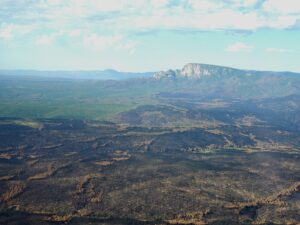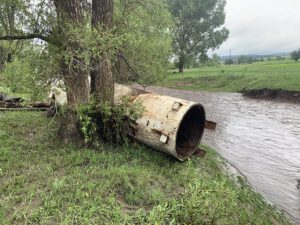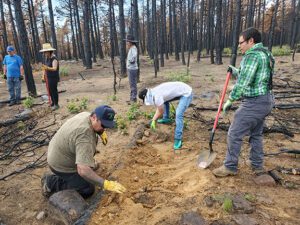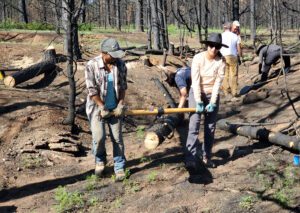By Alan Barton, NMFWRI Director
For the past three years, the month of April has distinct meaning to the staff at the

NM Forest & Watershed Restoration Institute and to the communities in northeastern New Mexico. It was in April 2022 that the Hermit’s Peak-Calf Canyon (HPCC) wildfire started. The fire was the result of two separate prescribed burns in early April that escaped, then exploded and merged into a megafire when the winds whipped up on April 22, now an infamous date in the region’s history. The HPCC Fire grew into the largest fire recorded to date in New Mexico, charring over 340,000 acres in the Sangre de Cristo Mountains throughout the summer of 2022.
The HPCC changed so much for so many people. The impacts from this fire are astounding: over 900 structures destroyed and hundreds of private landowners who lost their homes and forests and continue to face additional losses with every

rainstorm, thousands of people evacuated over the fire’s large footprint and extensive smoke damage to people and property, a prolonged water crisis in the community of Las Vegas that threatened the city’s water supply during and immediately after the fire and ongoing post-fire flooding events that have continued to shut down much of the town periodically due to contaminated water, many businesses throughout the region forced to shut down temporarily during the fire and post-fire events, and incalculable losses in community connections, social capital and local culture. The economic costs stretch into the billions of dollars and continue to mount, as the effects from this fire are not over and will continue to be felt for years.
The HPCC fire also changed national fire policy. As the fire progressed, the Chief of the U.S. Forest Service declared a temporary moratorium on prescribed burning and formed a task force to conduct a review of the agency’s practices, which resulted in a provocative report that challenged long-standing practices and recommended new approaches to address the new era of megafires. In introducing the report, Chief Randy Moore wrote, “Fires are outpacing our models and, as the final report notes, we need to better understand how megadrought and climate change are affecting our actions on the ground. We must learn from this event and ensure our decision-making processes,mtools, and procedures reflect these changed conditions.” The Government Accountability Office (GAO) issued a follow-up report in 2024, assessing the Forest Service’s progress in implementing changes in prescribed fire policy. The GAO saw clear progress on all aspects measured, and made recommendations on how to close gaps and fully achieve the planned reforms.
The HPCC fire changed NMFWRI as well. Prior to the fire, our focus was on support

for pre-fire treatments and wildfire mitigation. Once the HPCC exploded, our staff quickly pivoted and began developing support for local communities during and after the fire. We could not ignore a fire of this magnitude burning right in our backyard. Our GIS team quickly produced the New Mexico Fire Viewer, which tracked the growth of the fire in real time and provided information for communities on evacuations and resources. The Fire Viewer continues to track wildfires throughout New Mexico and is widely used. While the fire was still active, our Conservation Science Center (CSC) and Outreach staff initiated a series of

“Querencia in Action” workshops for private landowners. Each workshop helps landowners develop skills in various landscape management actions that support recovery. CSC and Outreach staff also began work with the Mora School District to help students with strategies for recovery from the fire, and to cope with the challenges they and their community faced. Our Monitoring crews had several ongoing data collection plots within the fire perimeter, and once the Forest Service was able to grant permission to enter the areas, crews began collecting data within plots that had burned, providing valuable information on how pre-fire treatments fared during the fire.
NMFWRI also participates in the development of the New Mexico Reforestation Center (NMRC), a joint project of New Mexico State University, University of New Mexico, Highlands University and the New Mexico Forestry Division. Seed collection operations are already in progress, plans for a nursery and greenhouses are in the works, and the NMRC plans to have seedlings to outplant in 2028. The NMRC has a goal of producing 5 million seedlings per year to reforest areas burned in the HPCC and other wildfires in New Mexico and neighboring states.
With increased support from the federal and New Mexico state governments, NMFWRI is now able to take a more comprehensive approach to forest and watershed restoration. We continue post-fire recovery work, as well as support for pre-fire treatments, including prescribed burns. This comprehensive approach more closely addresses the reality in fire-prone areas in the 21st century, as post-fire recovery work transitions into pre-fire mitigation work for the next fire. Despite the experience with the HPCC fire, prescribed burns continue to be one of the best tools for preventing destructive megafires and maintaining forest health.
